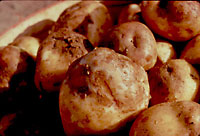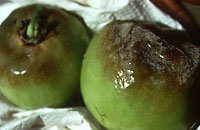Protocol: RG57 genomic DNA fingerprinting
Phytophthora infestans DNA extraction protocol
Reference: Goodwin, S. B., Drenth, A. and Fry, W. E. 1992. Cloning and genetic analyses of two highly polymrphic, moderately repetitive nuclear DNAs from Phytophthora infestans. Current Genetics, 22:107-115.
- Grow mycelium in pea broth using 2 agar plugs per 90mm petri plate and 2 petri plates per isolate. The mycelium is usually ready to harvest after 1 week.
- Harvest mycelium by filtering through a buchner funnel containing filter paper (whatman no.1). Place mycelium in a 2.2 ml microfuge tube and freeze at -80 C. Lyophilize tissue overnight or longer. The lyophilized tissue may be stored at room temp or at -20 C.
- Grind lyophilized mycelium in the microfuge tube using a flame sealed 1000 ml pipette tip.
- For DNA extraction, use 30-35 mg of ground, lyophilized tissue. This is the amount of tissue which fills a 2.2 ml microfuge tube to about 0.25 ml.
- Add 1.0 ml of extraction buffer, vortex and incubate at 65° C for about 1 hour.
- Add 333 ul 5M potassium acetate, vortex and place on ice 20 min.
- Spin in microfuge on high (14,000 rpm) for 10 min.
- Pour supernatant into a clean 2.2 ml microfuge tube and add 800 ul cold isopropanol. Mix by inverting the tube several times, and incubate on ice 30 min.
- Microfuge samples 10 min on high speed, pour off and discard the supernatant, and dry the pellets in the speed vac for about 10 min.
- Resuspend the DNA pellet in 500 ul TE buffer.
- Add an equal volume (500 ul) of phenol: chloroform; isoamyl alcohol (25:24:1), vortex and microfuge 5 min. Do this in the fume hood.
- Transfer the top, aqueous layer (which contains your DNA in TE) to a new 1.5 ml microfuge tube.
- Add an equal volume (500 ul) of chloroform: isoamyl alcohol (24:1), vortex and microfuge 5 min. Do this in the fume hood.
- Transfer the top, aqueous layer (which contains your DNA in TE) to a new 1.5 ml microfuge tube.
- Add 1/10 volume (50 ul) 3M sodium acetate and 2 volumes (1 ml) ethanol. Incubate at -20° C for at least 2 hours if the DNA is not visible.
16. Microfuge the samples for 10 min and pour off supernatant.
- Add 200 ul 70% ethanol and microfuge for 2 min to wash the DNA pellet.
- Dry pellet in speed vac for about 10 min and resuspend in 50 ul TE.
- This DNA should be stored at -20° C for long term storage or at 4° C for less than a week.
Solutions for DNA extraction
0.5 M EDTA pH 8.0
Add 186.1 g of disodium EDTA to 800 ml of H2O. Stir vigorously. Adjust the pH to 8.0 with NaOH (~20g of NaOH pellets). Sterilize by autoclaving (the disodium salt of EDTA will not go into solution until the pH of the solution is adjusted to approximately 8.0 by the addition of NaOH).
3M NaCl
Dissolve 175.32 g of NaCl in 800ml of H2O. Adjust volume to 1 liter. Sterilize by autoclaving.
20% SDS (Sodium dodecyl sulfate
Dissolve 200 g SDS in 850 ml of H2O. Heat to 68oC to make the SDS dissolve faster. Adjust the volume to 1 liter with H2O. Wear a dust mask when making SDS.
Extraction buffer
10 ml of 0.5 M EDTA
10 ml of 1 M Tris pH 8.0
16.6 ml of 3 M NaCl
0.7 ml of beta mercaptoethanol
1.25 ml of 20% SDS
Adjust volume to 100 ml with distilled water.
TE buffer (10 mM Tris, 1 mM EDTA)
1.0 ml of 1 M Tris pH 8.0
0.2 ml of 0.5 M EDTA
Fill with dH2O to 100 ml. Sterilize by autoclaving.
3M Sodium acetate (NaOAc)
Dissolve 408.1 g of sodium acetate trihydrate in 800 ml of H2O. Adjust pH to 5.2 with glacial acetic acid . Adjust the volume to 1 liter with H2O. Sterilize by autoclaving.
5M Potassium acetate
Dissolve 49.1 g potassium acetate in 70 ml dH2O, bring final volume to 100 ml. Sterilize by autoclaving.
Phenol : Chloroform: IAA (Isoamyl alcohol) (25:24:1)
100 ml saturated phenol
96 ml chloroform
4 ml isoamyl alcohol
Chloroform : IAA (isoamyl alcohol) (24:1)
96 ml chloroform
4 ml isoamyl alcohol
70% EtOH
736.8 ml of 95% ethanol.
Add distilled water to a total volume of 1 liter


